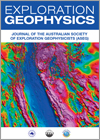
Exploration Geophysics
Volume 49 Number 4 2018
EG16163Predicting lightning sourced electromagnetic fields
Global lightning networks catalogue the time and location of up to four million lightning strikes per day. We use lightning network data to predict sferic arrival times, vertical electric field amplitudes and arrival azimuths at an audio-frequency magnetotelluric sounding near Heathcote, Victoria.
EG17007Application of full waveform inversion algorithms to seismic data lacking low-frequency information from a simple starting model
The low-frequency information and correct starting velocity are important for full waveform inversion (FWI). However, obtaining low-frequency information and accurate starting velocity from the field seismic exploration is difficult. This paper suggests a 4-phase FWI to invert the correct velocity model when a dataset lacks low-frequency information and accurate starting velocity.
EG17004Seismic signal denoising using thresholded variational mode decomposition
In this paper, we propose an adaptive denoising method based on data-driven signal mode decomposition, where the noise is represented by the residual/last mode. The proposed approach adaptively extracts the noise component depending on the data statistics rather than defining a fixed priori threshold.
EG17081Imaging the crustal structure along the KCRT-2008 profile in the Southern Korean Peninsula using regularisation
In this study, high-resolution subsurface structures of the southern Korean Peninsula were delineated. To acquire images, we applied seismic data processing tools that are commonly used in oil exploration to irregularly sampled data after regularisation by matching pursuit interpolation.
EG17012Hybrid absorbing boundary condition for piecewise smooth curved boundary in 2D acoustic finite difference modelling
Flexible computational domains with irregular absorbing boundaries can improve the efficiency of seismic modelling. We propose a hybrid absorbing boundary condition for piecewise smooth curved boundary in mesh-free discretisation based on radial-basis-function-generated finite difference modelling. Modelling examples in both homogeneous and heterogeneous media with flexibly shaped computational domain demonstrate the effectiveness of our proposed method.
EG17013Prestack depth imaging in complex structures using VTI fast marching traveltimes
A fast marching eikonal solver is employed in the isotropic and VTI concepts. Instead of using a linear eikonal equation, we consider a nonlinear approximation because it is more realistic and accurate than the former. Overall, anisotropic approach is stable, fast and generates high-quality images with accurate details in deep structures.
EG17039Modified imaging condition for reverse time migration based on reduction of modelling time
We propose a modification of the reverse time migration imaging condition by reducing the modelling time to about half of the recording time. Results showed that the proposed modification has no significant effect on the illumination of reflectors, while increasing the CPU and memory allocation performances by about 25% and 50%, respectively.
EG16157Forward modelling formulas for least-squares reverse-time migration
We derive two formulas of forward modelling for least-squares reverse-time migration based on Born and Kirchhoff approximations. Analysis unveils an iω difference exists between the two formulas. Consequently, their seismic images have different shape/phase: the Born approximation produces anti-symmetric images while the Kirchhoff approximation gives symmetric images. Numerical examples demonstrate these features between the two formulas.
EG16084Separation of different order multiples based on focal transform and SRME
Considering that the focal transform can flexibly perform order reduction or elevation of multiples and surface-related multiple elimination (SRME) can effectively separate primaries and multiples, a practical and novel method based on both the focal transform and SRME is proposed to separate different order multiples in this paper.
EG16158An elastic full-waveform inversion based on wave-mode separation
We propose an elastic full-waveform inversion method based on P- and S-wave mode separation to mitigate the crosstalk artefacts between P- and S-wave modes by deriving the gradient formulas with respect to various wave modes using a P- and S-wave mode separated first-order velocity-stress wave equation.
EG17015Modifications to the Kozeny–Carman model to enhance petrophysical relationships
In this study, the deficiency of the Kozeny–Carman assumption is investigated and alternative derived equations for the Kozeny–Carman equation are suggested, including equations where the grain size is replaced with the pore size and with varying tortuosity. Relationships for the permeability of shaly sand reservoir are introduced.
EG16123A new method to enhance the characterisation of seismically thin beds based on the generalised S transform maximum modulus
Thin beds are common in underground hydrocarbon reservoirs, but rarely detected and characterised. In this work, we propose a new method to improve characterisation of thin beds and we are able to find and characterise more thin beds accurately. This new method will enhance our ability to discover more oil and gas.
EG16148Revised potential field model of the Gilmore Fault Zone
The Gilmore Fault Zone marks a distinct geophysical and complex geological boundary. This work improves on existing models of this fault zone and presents a revised potential field model. These models of the subsurface morphology of this major thrust and/or strike-slip fault system are being used to refine tectonic models for the evolution of the Eastern Lachlan Orogen.
EG17085Three-dimensional gravity inversion using automatic regional-residual components separation with application to the Iwaki area in Fukushima Prefecture, Japan
We propose a simple method for analysing gravity data to define 3D subsurface structures based on automatic separation of gravity anomalies into residual gravity and trend surfaces. This is achieved by assuming that the gravity anomaly trend surface is extremely smooth prior to analysis. The new method was applied to an area around Iwaki City, Fukushima Prefecture, Japan, and the results evaluated using a boot-strap simulation.
EG17016Topographic correction of magnetic data on rugged topography with application to Río Blanco-Los Bronces and El Teniente porphyry copper districts, Southern Andes, Chile
This paper describes a semiquantitative, 3D-modelling based methodology that has been developed to remove topographic effects on magnetic data. Through synthetic and real cases in the Andes, we show that airborne magnetic surveys over rugged topography generate magnetic signatures that could be of similar amplitude with the signal of geological interest.

